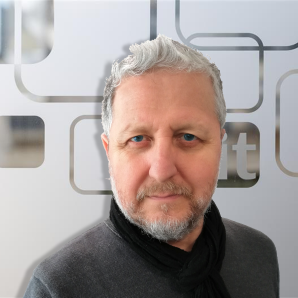
Istituto Italiano di Tecnologia
Description
The Italian Institute of Technology (IIT) is a scientific research centre focused on promoting excellence in both basic and applied research, with a view to facilitating Italian economic development. The main objective of this research is to create technologies that can positively impact important societal challenges such as sustainability and the environment, healthcare, and aging society, reflecting the priorities of the EU. Currently, IIT is engaged in developing four broad strategic research domains, namely Nanomaterials, Robotics, Computational Sciences, and Technologies for Life Science.
Located in Venice, the Centre for Cultural Heritage Technology (CCHT) is one of IIT's centres that seeks to encourage interdisciplinary collaborations in 'frontier' projects, combining established approaches to cultural heritage conservation and digital humanities with the latest advancements in technology and science. CCHT leverages the close cooperation among researchers and their interactions in an environment of scientific excellence, focusing primarily on Computer vision, Artificial Intelligence, Robotics and Nanotechnologies.
Regarding conservation and preservation, the centre aims to develop the next generation of green, nanostructured, and sustainable treatments to protect various cultural heritage materials such as glass, metals, frescos and wall paintings, mosaics, and ancient documents.
Contribution
IIT will contribute its research expertise in three key areas to the GoGreen project as follows:
1. Conservation science: aiming at developing and assessing new green materials for consolidating glass;
2. Computational science: focusing on developing AI methods to automatically detect and identify alterations of heritage materials;
3. App development: seeking to prototyping a Decision Support Tool that will assist conservators in making environmentally conscious decisions about preservation, cleaning, and conservation treatments.

Dr. Arianna Traviglia
Dr. Arianna Traviglia is the Coordinator of the IIT Centre for Cultural Heritage Technology (CCHT). Dr. Traviglia’s work is placed at the intersection of technology and humanities and most of her research focuses on mediating the inclusion of digital practices within the study and management of cultural heritage. Her expertise lies mainly in multi and hyperspectral image processing (close and far range) for the analysis of cultural landscape and material culture.

Dr. Giulia Franceschin
Dr. Giulia Franceschin is a Material Engineer and researcher in Conservation Chemistry and Materials at the Center of Cultural Heritage Technology of the IIT in Venice. Giulia is specialized in the design and study of materials and nano-structured systems. Her research is currently focusing on the multi-scale analysis of the physicochemical and structural properties of ancient materials (ceramics, metal alloys, glassy surfaces), to improve the understanding of the alteration mechanisms involved and define innovative protective strategies based on non-toxic and sustainable formulations.

Dr. Roberta Zanini
Post-doctoral researcher in Conservation Chemistry and Materials at the Center of Cultural Heritage Technology of the IIT in Venice. She is specialized in the study of the mechanism of corrosion of ancient glass and its process using multi analytical technique to investigate the material from the microscopical to the nanometric scale, from the bulk to the surface layer composition. She is interested in chemical and surface characterization by Laser Ablation Inductively Coupled Plasma Mass Spectrometry (LA-ICP-MS) of ancient materials for understating the provenance the raw materials, the manufacturing and the state of conservation of artefacts. Her research is actually focusing on the design of nanomaterials as an ideal protective coating to stop the alteration process limiting the interaction between surface of the ancient glass and its conservation environment.

Dr. Mauro Moglianetti
Researcher within the Centre for Cultural Heritage Technology at IIT in Venice. His research is now focused on the development of innovative nanomaterials for application in cultural heritage with the aim to overcome the limitations of polymeric approaches for protection and consolidation. The overarching aim of his research is to create highly engineered nanomaterials able to perform tasks within different environments thanks to their enzymatic/catalytic abilities powered by their surface properties. The design motifs are based on nanoparticles with tailored properties synthesized by innovative protocols and characterized to reach the highest performance required by the application. Out-of-the-box approaches, such as naked-eye anticounterfeiting tags or portable diagnostic kits have been developed thanks to this disruptive mindset.

Dr. Giorgio Brugnone
Dr. Giorgio Brugnone is a Computer Science Engineer, Solution Architect, and Full Stack Developer at the Cultural Heritage Technology Center of IIT in Venice. He specializes in the design and implementation of advanced information systems, including web applications, dashboards, and control panels, utilizing the latest and most secure front-end, back-end, and database technologies. His current work is focused on prototyping a Decision Support Tool for restorers, aimed at facilitating innovative and sustainable choices in materials, techniques, and strategies, thereby enhancing both personal and environmental green awareness.
List of up to 5 publications:
- Aresani, A., Di Turo, F., Zucchelli, M., Traviglia, A. Recent Advances in Protective Coatings for Cultural Heritage–An Overview. Coatings 2020, 10, 217. Short description: This article reviews the progress, the technical challenges, and the most recent advances in protective coatings for archaeological metal, glass, and stone artefacts.
- Fiorucci, M., Khoroshiltseva, M., Pontil, M., Traviglia, A., Del Bue, A., James, S. Machine Learning for Cultural Heritage: A Survey, Pattern Recognition Letters, 133, 2020, 102-108. Short description: This literature survey describes advances of machine learning in cultural heritage analysis, protection and conservation.
- Di Turo, F., Moro, G., Artesani, A. et al. Chemical analysis and computed tomography of metallic inclusions in Roman glass to unveil ancient coloring methods. Sci Rep 11, 11187 (2021). Short description: This paper investigates corrosion and structural morphology of two metallic inclusions found in a roman glass artefact.
- Artesani A., Ljiubenovic M., Bonetti S., Traviglia A. Processing and analysis of THz time-domain spectroscopy imaging applied to cultural heritage. The International Society for Optical Engineering, 11784. Short description: This paper discusses the improvement of approaches to retrieve information on material composition and surface topography in the far-infrared region.
- Di Turo, F., Artesani, A., Pasquale, L., Debellis, D., Traviglia, A. Electrochemical relative dating of Roman leaded-bronze coins from plough soil. Journal of Archaeological Science: Reports. Short description: This paper describes the process of determining the relative chronology of a group of corroded and severely disfigured Roman lead-bronze coins using an electrochemical dating method.
List of up to 5 most relevant previous projects or activities, connected to the subject of this proposal:
- REPAIR REconstructing the Past: Artificial Intelligence and Robotics meet cultural heritage H2020-FETOPEN – GA 688920. This project aims at analyzing Roman frescoes from Pompeii using advanced forms of characterization, including hyperspectral imaging combined with application of machine learning methods.
- NETCHER NETwork and digital platform for Cultural Heritage Enhancing and Rebuilding H2020-SC6- TRANSFORMATIONS-2018 – GA 822585. This project aims at building a social and digital platform to connect actors engaged in the protection of Cultural Heritage using a participatory approach.
- RUTE Revealing Unseen TExt with THz waves, MSCA-IF-2020 – GA 101026453. This project focuses on advancing characterization and analysis of cultural heritage assets using Terahertz combined with Computer Vision approaches.
- MEMEX MEMories and EXperience for inclusive digital storytelling H2020-SC6-TRANSFORMATIONS-2019 – GA 870743. This project creates digital tools to promote social cohesion in citizens working for protection of Cultural Heritage, implementing social science-based actions to understand the needs of communities and co-design interfaces to suit their needs.
- OPTIMAL OPtimal Transport for Identifying Marauder Activities on LiDAR MSCA-IF-2020. – GA 101027956. This project develops automatic means of identifying threatened Cultural Heritage. The project also assembles cultural datasets and makes them publicaly available to be used free of charge.
